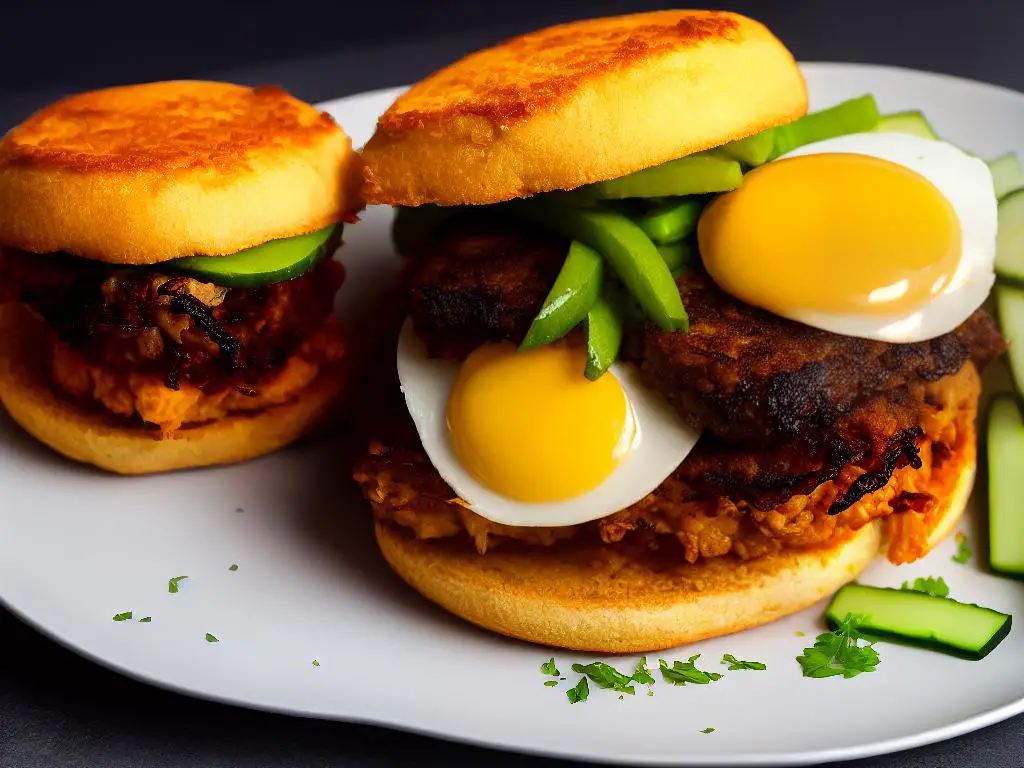Intertwining cultural heritage and global food trends often leads to the creation of distinctive delicacies that hold a mirror up to society’s evolving tastes. One such example is Nasi Lemak, a cherished culinary symbol of Malaysia and its diverse gastronomic landscape. In an intriguing twist of contemporary gastronomy, McDonald’s Malaysia, a global fast-food giant, has adorned its menu with a colourful rendition of this cherished traditional dish, introducing the Nasi Lemak Burger. Through an exploration of the historical significance and cultural prominence of Nasi Lemak, closely followed by a detailed investigation into McDonald’s Malaysia’s interpretation of it, this discourse aims to uncover the curious marriage of tradition and teeming international food culture.
History and influence of Nasi Lemak in Malaysia
Origins and Historical Background of Nasi Lemak in Malaysia
Nasi Lemak is one of Malaysia’s most cherished dishes, deeply rooted in the nation’s cultural heritage. The origins of Nasi Lemak, translating to ‘rich or fatty rice’, can be traced back to the 19th century, predominantly among the Malayan communities. Traditionally, it was considered a breakfast meal. However, the delicacy’s universal appeal quickly transcended it into a dish revered at all times of the day.
It is prepared by cooking rice in coconut milk, which gives it a creamy texture, and served with a wide assortment of side dishes. The standard accompaniments include spicy sambal, crispy anchovies, boiled eggs and crunchy peanuts. Cucumbers are also typically served to balance out the rich and spicy flavours.
Cultural Significance of Nasi Lemak in Malaysia
Nasi Lemak holds a central position in the tapestry of Malaysian cuisine. The dish is ubiquitous in the country, regardless of the time or occasion, symbolising the culinary unity in a nation known for its diversity. Given its historical significance and deep-rooted connection with the people of Malaysia, Nasi Lemak is appropriately considered the national dish of Malaysia.
Moreover, its simplicity, affordability and easy accessibility make Nasi Lemak a common go-to meal for Malaysians. From roadside stalls to fancy restaurants, Nasi Lemak can be found everywhere in the country. It has become a significant fixture in religious celebrations, social gatherings and everyday life in Malaysia.
McDonald’s Malaysia Nasi Lemak
Recognising the importance and universal appeal of Nasi Lemak, McDonald’s Malaysia introduced its version of the dish in its menu in 2017. The move was part of the company’s strategy to show respect and appreciation towards local food culture while expanding its customer base in the region.
McDonald’s Malaysia Nasi Lemak Burger, aptly named the ‘Nasi Lemak McD’, quickly grew in popularity. It reinvents the traditional dish in the form of a burger, containing a coconut-flavoured chicken thigh patty, a fried egg, caramelised onions and refreshing cucumber slices, served with sambal sauce. The burger successfully merges two universally adored food items, the traditional Nasi Lemak and the classic McDonald’s burger.
Influence of Nasi Lemak on McDonald’s Malaysia
The introduction of the Nasi Lemak McD exemplifies the profound influence of Nasi Lemak on Malaysia’s fast-food culture. Surprisingly, it has reached the likes of international brands such as McDonald’s, affirming the dish’s prevalent significance and its deep-seated bond with the Malaysians.
McDonald’s Nasi Lemak has achieved immense success, signifying how local flavours and culinary traditions can retain their places along with the surge of globalisation. McDonald’s Malaysia has leveraged the popularity of Nasi Lemak efficiently, promoting its integration and preservation in a contemporary yet international context.
Essentially, the debut and approval of the McDonald’s Malaysia Nasi Lemak signify a mutual relationship between local food traditions and global corporations. The cultural potency and sustained popularity of Nasi Lemak in Malaysia’s culinary landscape provide it with credibility, even amidst international fast-food giants. Henceforth, Nasi Lemak, inclusive of its McDonald’s rendition, shall continue to epitomise traditional Malaysian cuisine in a modern, globally recognisable form.

McDonalds Malaysia’s Nasi Lemak Burger
The Nasi Lemak Burger at McDonald’s Malaysia
At McDonald’s Malaysia, the menu item that has successfully headlined the local food scene and stolen the hearts of locals and foreigners alike is the Nasi Lemak Burger. This innovative version of the classic Malaysian dish, Nasi Lemak, bridges the gap between Malaysia’s diverse food culture and the modern fast-food scene. Presented by McDonald’s Malaysia, the Nasi Lemak Burger beautifully captures and celebrates both domains.
Ingredients
The Nasi Lemak Burger embodies the primary elements of the authentic Nasi Lemak dish, with the incorporation of crispy chicken or beef patties seasoned with spicy sambal sauce, sunny side-up eggs, caramelised onions and refreshing cucumbers. These replace the traditional fish or chicken, boiled eggs, fried anchovies, peanuts, and vegetable additions that usually accompany the dish. The sambal sauce used in the burger is a critical component and is locally sourced to maintain the unique flavour profile. The typical bun used in McDonald’s burgers has been replaced by a semi-sweet, coconut-flavoured pair of buns to echo the essence of nasi lemak’s coconut rice.
Preparation Process
Experts curate the preparation process of the Nasi Lemak Burger at McDonald’s Malaysia to preserve the sanctity of the original dish. The patty used in the burger, either chicken or beef, is marinated and breaded to achieve a crispy texture while ensuring juicy within. Once cooked, a generous amount of sambal sauce is applied to the patty, complying with the rich spiciness that traditional Nasi Lemak is known for. The final touch includes a sunny-side-up egg, caramelised onions and delicious cucumbers to further elevate the composition. Covering this delectable mix is a pair of buns enriched with coconut for that identifiable hint of Nasi Lemak.
Customer’s Feedback and Reviews
Since its debut, McDonald’s Malaysia’s Nasi Lemak Burger has garnered mixed but predominantly positive reviews from customers. The burger’s successful likeness to the traditional dish and inventive integration of fast-food features has sparked extensive commendation. Patrons appreciate the blend of cultural identity with modern fast-food mannerisms, echoing sentiments of nostalgia and innovation simultaneously.
Few critiques, however, address the lack of “nasi” (rice) in the burger, despite the dish’s namesake, transgressing the fundamental aspect of the traditional dish. However, it is still applauded for encompassing the characteristic flavours of traditional Nasi Lemak within a burger’s confines.
A Comparison to Traditional Nasi Lemak
The Nasi Lemak Burger from McDonald’s Malaysia diverges from its traditional Malay counterpart. While it isn’t an exact replica, it smartly incorporates key aspects of the beloved dish via a modern interpretation. Essential elements such as a crispy chicken or beef patty, coconut-flavoured buns and sambal sauce have been curated, reinventing the classic motif into a modish creation.
To sum up, the Nasi Lemak Burger offered by McDonald’s Malaysia represents a fusion of time-honoured local tastes with global fast-food trends. McDonald’s Malaysia manages to preserve the essence of the significant dish while serving an innovatively crafted variant that both purists and culinary explorers can cherish. It’s a creative approach to an emblematic local meal, symbolising a harmonious blend of traditional culinary practices alongside the modern evolution of fast food.

Impact of McDonalds Malaysia’s Nasi Lemak on the local food culture
McDonald’s Malaysia’s Launch of Nasi Lemak
The introduction of Nasi Lemak, a customary Malaysian delight, to McDonald’s Malaysia’s menu was a strategic manoeuvre to appeal to its local customers, simultaneously sustaining their global fast-food aspects. This initiative by an international fast-food titan to adapt and serve a closely treasured local delicacy raised quite a few eyebrows as Malaysians hold their culinary legacy in high regard.
The Acceptance and Reactions of Malaysians
Upon its arrival on the McDonald’s menu, Nasi Lemak sparked a mixture of reactions from local Malaysians. For some, seeing a beloved traditional dish being served in a fast-food chain was a matter of pride. McDonald’s bold step of recognising and incorporating Malaysian food culture into their offerings was seen as a reflection of the country’s rich and diverse culinary scene.
On the other hand, there were some who viewed this move with scepticism and thought it to be an inappropriate blend of globalisation and cultural appropriation. Many voiced concerns about the authenticity of the McDonald’s version of Nasi Lemak. It was feared that the fast-food giant, known for its Western-style burgers and fries, might not do justice to the traditional recipe, which comprises coconut-milk infused rice, sambal (spicy sauce), hard-boiled egg, cucumber slices, peanuts, and crispy anchovies.
Its Influence on the Local Food Scene
Regardless of the differing views, McDonald’s Nasi Lemak undeniably made an impact on Malaysia’s local food scene. The fast-food chain’s interpretation of the dish encouraged other restaurants and eateries to experiment with their own renditions of Nasi Lemak. While some purists might have bemoaned the shift away from the traditional recipe, this culinary experimentation fostered an environment of innovation and creativity within the local food scene. It sparked a trend of “Nasi Lemak fusion”, leading to the creation of dishes such as Nasi Lemak sushi, Nasi Lemak burgers, and even Nasi Lemak cakes.
The Implications on the Hybridization of Food Culture
Looking beyond Malaysia’s shores, McDonald’s Nasi Lemak, can also shed light on the global implications of hybrid food culture. It presents a fascinating case study of how global entities can tap into local tastes, intermingling different cuisines to create something familiar yet new, appealing to both local and global tastes.
This hybridity is not without controversy, as it implies a certain evolving or eroding of traditional food cultures by the worldwide uniformity associated with global fast-food chains. Critics argue that while the fusion cuisine can give traditional dishes an innovative twist, it can also dilute authentic culinary legacies.
In conclusion
The integration of Nasi Lemak into McDonald’s Malaysia’s menu has not only fuelled conversation around food culture in Malaysia but prompted larger global discussions around the fusion of food, cultural identity, and the role of global corporations in influencing local traditions. It’s an intriguing example of how food can both link and divide cultures, revealing the complexity entwined in a single plate of aromatic rice.

Fast food’s foray into the sanctum of traditional cuisines, encapsulated in McDonald’s Malaysia’s Nasi Lemak Burger, inherently forms a pulsating dialogue concerning the preservation of culinary traditions and the modern food industry’s relentless drive for innovation. The Nasi Lemak Burger, while a testament to the versatility and global appeal of Malaysia’s beloved national dish, also triggers crucial conversations about cultural intrusion and potential hybridisation of food culture. Whether these adaptations are seen as flavourful tributes or gastronomic misinterpretations, they undeniably underline the continual evolution of food; reflecting shifting tastes and symbolising the ongoing cultural exchange in our increasingly globalised world.
